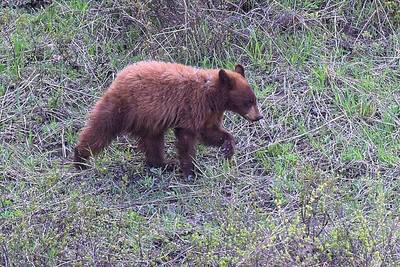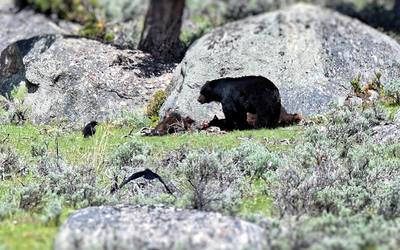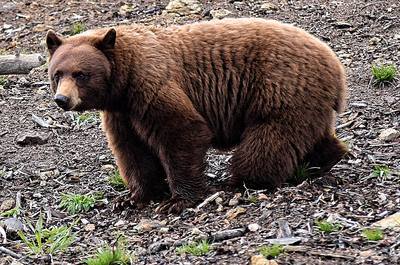|
The unique science behind color: Interesting enough, color is one of the many things that people attempt to use to differentiate species of bears. Uniquely enough, black bears are not always black, grizzlies are not always brown.
Most of the time, black bears you encounter in the forests in the eastern United States are black in color. Occasionally, you will encounter small numbers of non-black colored black bears, but it is not very common. "Non-black black bears make up a higher percentage of populations going from east to west across Ontario, the Great Lakes region; these bears account for 5-10% of populations in western Ontario and Minnesota. Color ratios in the western regions of North America vary, from predominantly black, to predominantly non-black. The percentages of black individuals within populations decreases from north to south in the Rocky Mountain region and from the Pacific Coast inland. Black coloration occurs most frequently in very dense boreal, northern montane forests and temperate rain forests. Non-black coloration is found more commonly in open forest on the lower slopes of the northern and central Rocky Mountains, interior mountains in California, and desert ranges in the southwestern United States." --Rounds, R. C. (1987). Distribution and analysis of colourmorphs of the black bear (Ursus americanus). Journal of Biogeography, 521-538.-- These images of black bears were taken inside Yellowstone National Park. Color variation inside Yellowstone varies from black, brown, cinnamon and blonde. It is important to realize that color is not a very good indicator to identify species (grizzly vs. black). Color alone cannot identify a bear.
0 Comments
Leave a Reply. |
AuthorTyler Brasington is a native born and raised Pennsylvanian, yet proud current Wisconsin resident. He graduated from the University of Wisconsin-Whitewater with a B.S. in Environmental Science. Currently, Tyler is pursuing his masters in Natural Resources with the University of Wisconsin-Stevens Point. He has worked in Yellowstone National Park under the guidance and supervision of Dr. George Clokey and Dr. Jim Halfpenny. Disclaimer: The information and views expressed on this page do not necessarily represent the views of the Department of Interior, US Geological Survey, National Park Service or the United States Government.
The Greater Yellowstone Grizzly Project
www.yellowstonegrizzlyproject.org © 2021 Tyler Brasington All rights reserved. No portion of this website may be reproduced in any form without permission from the publisher, or appropriate authors, except as permitted by U.S. copyright law. For permissions contact: [email protected] Archives
February 2021
Categories |
- Welcome
- Home
- About
- Submit sightings
- Family Tracker
- Publications & Research
- Natural Life History
- Cementum Age Determination for Grizzly Bears
- Nutrition & Diet
- Radio Telemetry and Wildlife Tracking
- Chemical Immobilization and Wildlife Handling
- Infectious Disease in Bears
- Effects of Wildfire on Grizzly Bears: Yellowstone 1988
- Mortality Database
- Photo gallery
- Contact






 RSS Feed
RSS Feed